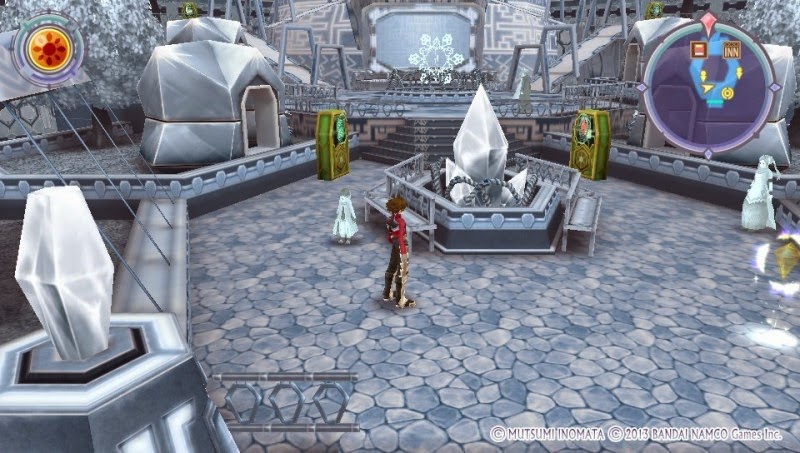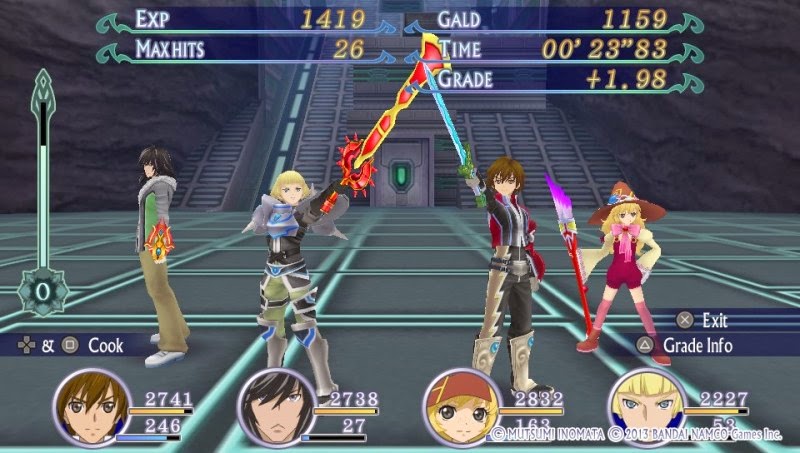Search This Blog
Tuesday, June 2, 2015
Tales of Hearts R (Vita)
Tales of Hearts R is a PlayStation Vita exclusive. However, it is not a native title for the platform; rather, it is a remake of Tales of Hearts released for the Nintendo DS in 2008. What makes Tales of Hearts R special is that the DS version was never localized and released outside of Japan. This is the first time that the eleventh flagship title in the Tales of series to be experienced by non-Japanese fans. The R stands for "Re-imagination" or "Remake". This is not a simple port, many aspects were overhauled compared to the original game. Obviously, the graphics are improved, although they aren't spectacular, they are actually fairly decent.
There are some low res textures though, especially in the field map but towns, dungeons and battle screens are detailed and crisp. Character models noticeably have more details to them compared to other objects. The battle system was rebuilt and it is a complex beast. Called the Aerial Chase Linear Motion Battle System, the core gameplay is your standard Tales of battle system, you have normal artes executed by pressing the X button, these are your normal attacks. Then there are Will Artes which are your special attacks/magic which is executed by pressing the O button. The battles take place in a 3D arena separate from the field. You have the ability to jump which makes juggling enemies in the air easier.
During battle, you can either use the left analogue stick to free run or use the D-pad to travel directly to your enemy target. I find using the D-pad to execute artes to be much easier. This is an action based battle system; you control one character with three AI-controlled characters. You're able to set strategies such as specifying them to heal when an ally's HP reaches a predetermined threshold, this allows more control over their behavior. There is a gauge on the left hand side which when filled, allow you to attack quicker and immune to being staggered for a short amount of time. During higher levels (the gauge has four levels), you can also execute Mystic Artes, which are the characters' ultimate attacks.
The other noteworthy mechanic is the Chase system. By delivering a certain number of hits to your enemy, you can automatically knock them into the air and "Chase Link". This allows you to instantly warp to your enemy by pressing the square button. During this period, you can execute a finish move by yourself, execute a paired attack during opportune moments and forces the enemy to stagger whenever you attack them. All the unique aspects of the system works well together to form a deep battle system that's heaps of fun. Leveling up is cool as well in that it uses the Soma system. You spend the points you gain when you level up in one of five areas, which determines which stats are boosted and which abilities you learn. Once again, it gives you more control over your characters and more personalization.
Cooking makes a return in that you need to obtain recipes (through purchasing or being given by NPCs), then purchasing the right ingredients before you can cook. You usually cook right after a battle or after resting at an inn. It brings a variety of effects such as increasing defense for the next four battles or healing one of your characters. Tales of Hearts R evokes the classic JRPGs from the 1990s. It brings back random encounters, which while annoying when you first realize this to be the case but actually isn't too bad. The encounter rate is perfectly balanced: not too high but not too low such that you're underleveled either.
The random encounters can eventually get on your nerves towards the end of the game, particularly in the last dungeon where you have to solve a puzzle using trial-and-error tactics following a bit of a runaround the place. You would walk a few steps and before you're halfway to the switch, you have to battle something. Another thing that's reminiscent of older JRPGs are save points. You can only save on the overworld or at save points in dungeons. This may sound like a bad thing but there are no absurd difficulty spikes to make you lose hours of progress. You can usually tell when a boss battle is coming up since there's a save point before every one of them. Boss battles provide a good challenge without devastating your party.
Of course, all of this assumes you're playing on Normal difficulty. True to its name, Hard is quite difficulty if you decide to play on it from the get go. There is also unlockable difficulties called Maniac and Unknown, which can be very tough. Apart from the battle transition, there are three main types of areas in this world. Dungeons, which are self-explanatory: you explore and uncover the map, find treasures, fight monsters and push the story forward. Towns are where you'll restock and heal, talk to NPCs and scavenge for any sidequests. Then there is the World Map. Yes! It has a classic World Map (where the character is grossly out of proportion) for you to explore.
Of note, all areas are blank when you first arrive; you have to uncover the paths through exploring them yourselves. While there aren't too many branching paths in dungeons and whatnot, it is actually quite easy to get too distracted while exploring what the World Map has to offer. From time to time, dungeons will force you to solve puzzles. They start out easy, like flipping a few switches but eventually get somewhat difficult as the puzzles are based on patterns. You have to figure them out either through deduction or through trial-and-error. The camera is fixed while you're in towns and dungeons, which feels really restrictive. The World Map on the other hand, allows you to rotate the camera however way you want it.
The story may be Tales of Hearts R weakest aspect but it is by no means bad. Early on in the story, you realize why it is called Hearts. It follows Kor Meteor, who meets a girl called Kohaku (and her brother). Through the actions of Kor, he now has to travel around the world to help heal Kohaku, banding together several party members along the way. This will then escalate into your typical save the world type of story, and it can stray towards the cliche side while never actually becoming cheesy or corny. The best part is that Tales of Hearts R nails the relationship building between characters so that you can see the changes in their attitude over the course of the game. This also allows you to start caring for the characters too.
The ending was great; it's a feel-good ending which wraps things up quite nicely. You do feel a sense of sadness once the game ends and you realize how much you have been enjoying it. The story takes around 35 hours to complete without rushing anything. Perhaps the most surprising aspect of Hearts R is how well the humor is sprinkled in the story. There were many comedic moments, from the dialogue to a character's actions. Skits are present here. After major story moments, various skits become available in which you press the Select button to open up some additional dialogue. These provide more backstory and banter between the characters. They are told via 2D portraits and not all of them are voiced (the game also presents skits as a way to remind players where they need to go next). A lot of these skits are entertaining and funny.
While the game has been translated into English, the developers have decided to retain the Japanese voiceovers, which is not a bad thing. They are fantastic and even though you don't natively understand what they are saying, you feel the huge amount of emotion that was expressed into the dialogue by the voice actors. The story is told via animated cutscenes and 3D rendered cutscenes. The animated cutscenes are where some of the DS roots can be seen. This is because some of the animated cutscenes are rendered in 4:3 aspect ratio (i.e. there are black borders to the left and right of the screen) while the additional cutscenes exclusive to Hearts R fill up the whole widescreen of the Vita.
The animated cutscenes do not seem to be as clear and crisp as they could have been, on the contrary, they seem to be fuzzy at the best of times. Once you have completed the game, as is Typical of Tales of games, there is a New Game Plus. This is complete with a grade shop which allows you to use grade (built up during your first playthrough) to decide what you want to carry over, such as your levels, items or gold. You can even unlock the full bestiary too. Plus, there is a post-game dungeon which contains some tough bosses and good weapons. The main story itself is bursting with content, with numerous sidequests, 76 "namcoins" to collect and an arena to test your battle skills.
Overall, Tales of Hearts R is a fantastic game. It takes a short while to get used to the slightly different battle controls but it is worthwhile. The battle system is easy to pick up but very complex such that you won't get bored as you master its mechanics one by one. The characters are likable, there's plenty of humor and the story is solid. In my opinion, it is a better game than Tales of Xillia. Tales of Hearts R is highly recommended if you are a fan of JRPGs.
--------------------------------------------------
For other game reviews, including Vita and PS3 games, check out this page.












